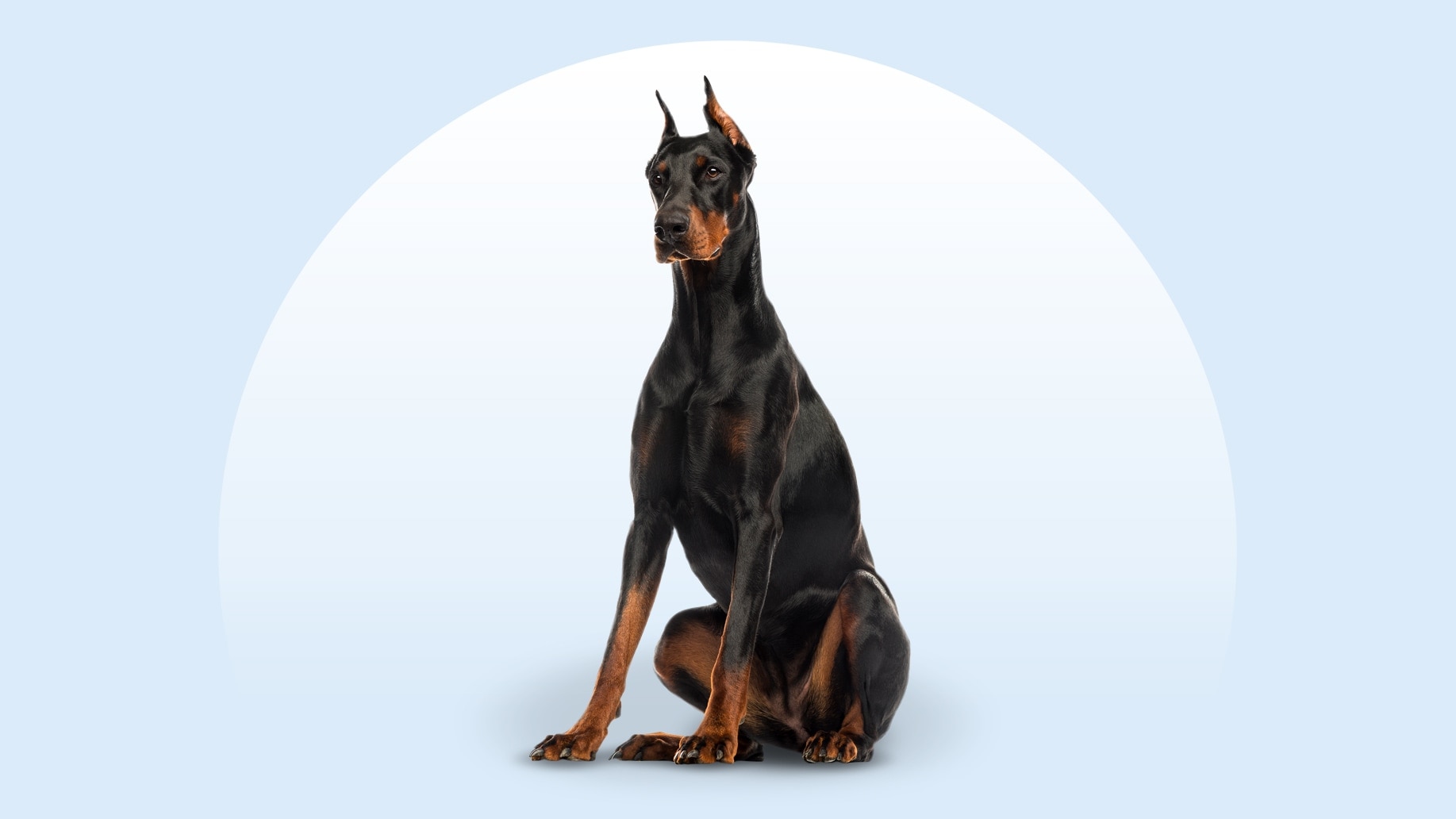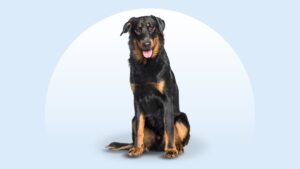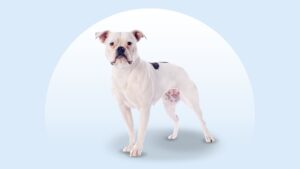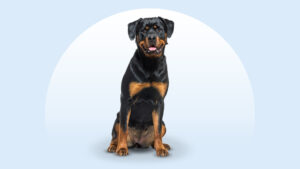Doberman Pinscher
Updated January 7, 2025
Doberman Pinscher
Updated January 7, 2025
The Doberman Pinscher is a large, sleek and muscular breed originally bred in Germany to be a guard dog. Though they have a long history serving as protectors, these highly trainable, energetic dogs also make devoted companions and excel in active families.
Devoted, Protective, Sensitive
Male: 75-100 pounds
Female: 60-90 pounds
Male: 26-28 inches
Female: 24-26 inches
10 to 12 years
Black and Rust, Red and Rust, Blue and Rust, Fawn and Rust
Though known for their imposing, tough-dog exterior, underneath you’ll discover Dobermans actually have a heart of gold. Bred to serve as protectors, Doberman Pinschers have long-excelled as guard dogs and police and military dogs. But make no mistake: The Doberman Pinscher is a fun-loving, family-oriented dog with an up-for-anything personality, especially if it’s a run around the neighborhood.
Doberman Pinscher Characteristics
Doberman Pinscher Appearance
Sleek and muscular, Dobermans project a proud and powerful appearance. Black with rust markings is the most common of the Doberman colors, and the breed is generally solidly built and compact, with an attentive and observant expression.
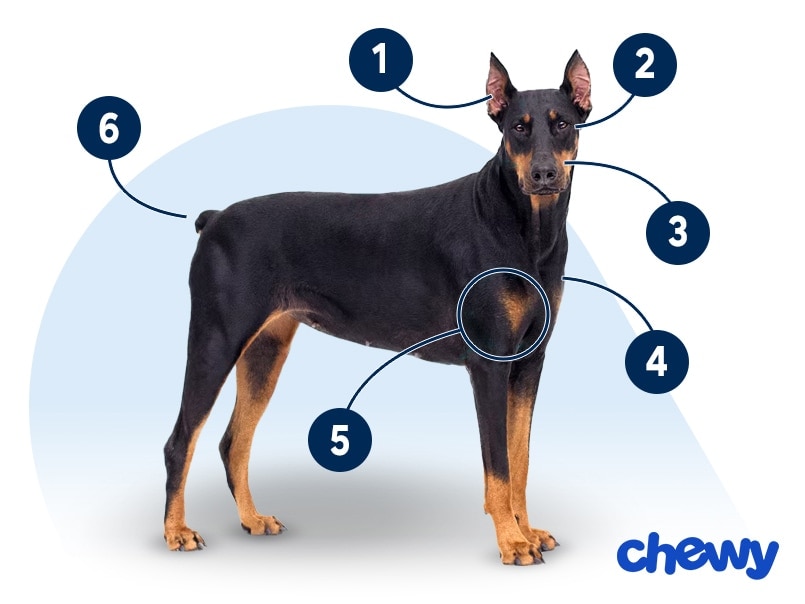
- Ears
A Doberman's ears are typically cropped, per the American Kennel Club. Cropping involves surgically cutting away part of a dog’s ears. Veterinary groups along with many U.S. states and countries have banned this procedure due to medical and behavioral reasons. If you are interested in this procedure, schedule a consultation with your veterinarian.
- Eyes
Their eyes are almond-shaped and mid to dark brown for dogs with black coats; otherwise, their eye color is similar to the surrounding fur. The darker the iris, the better!
- Nose
The Dobie's nose is black, brown, gray or tan, depending on their coat color. The overall muzzle shape is long and narrow.
- Coat Length
The Doberman's coat is smooth and short.
- Coat Color
They come in a variety of colors: black, blue, fawn (Isabella) or red, with reddish-brown markings.
- Tail
The AKC standard calls for the tail to be docked. Docking involves cutting a portion of the dog’s tail off when they are puppies. Veterinary groups along with many U.S. states and countries have banned this procedure due to medical and behavioral reasons. If you are interested in this procedure, schedule a consultation with your veterinarian.
Doberman Pinscher Temperament
Dobermans are highly intelligent, athletic and alert—all things that make them great guard dogs, which is what they were bred to do. And Dobies take their job as guard dog extraordinaire very seriously. This drive, along with their imposing physical appearance, has earned them a reputation of being notoriously protective. But when the pup parent provides the proper training, socialization and structure, these dogs are also a loving member of the family.
You’ll soon discover that, along with their formidable presence, Dobermans possess a deep devotion to their people. In fact, they bond so deeply with their humans and are so dedicated to their families, these affectionate dogs are sometimes referred to as “Velcro dogs.”
In addition to their work as guard dogs, Dobermans have a long history as police and military dogs, dating back to the early 20th century. Dobermans even assisted U.S. Marines during World War II.
How to Care for a Doberman Pinscher
Caring for a Doberman isn’t rocket science, but there is definitely some work involved, as with any dog. While their grooming needs are fairly easy to keep up with, Dobies require a good amount of daily exercise and lots of training. With all that training and time spent together, you’ll quickly build a tight bond with this super-smart dog.
Grooming
Training
Diet
Exercise
Environment
Doberman Pinscher Health
Hopefully, your Doberman is a healthy dog who happily reaches their 10- to 12-year lifespan with little or no trouble. That said, there are some Doberman health problems and conditions that commonly affect this breed.
- Dilated Cardiomyopathy (DCM): DCM is an inherited disease that affects the heart muscle and is commonly seen in Dobermans. In dogs with DCM, their heart muscle is weakened and cannot pump blood effectively. Over time, this leads to heart enlargement (dilation) and can result in complications like abnormal heart rhythms (arrhythmia), difficulty exercising and heart failure. Screenings should be done annually. Several drugs are used to treat the symptoms and help prolong life.
- Von Willebrand Disease: This is a genetic disorder that affects the ability of blood platelets to clot properly, which can lead to excessive bleeding from injuries. One study showed that over 70 percent of Dobermans are carriers, although not all show signs of the disease. Your veterinarian can screen your dog for it.
- Wobbler Syndrome: This is a problem with larger dogs like Dobermans. Issues with the spinal cord in the neck cause considerable pain and may affect the legs (especially the hind legs). Dobermans may begin showing signs of the disease—like a lack of coordination—around age 6, and some are treated with medications while others may need to undergo surgery.
- Hip Dysplasia: This is an inherited issue involving the hip joint that results in pain, muscle loss and lameness. It’s a degenerative disease, but there are many treatments and therapies available. Hip dysplasia can affect any dog, but it’s more common in larger breeds, such as Dobermans.
- Bloat: Otherwise known as gastric dilatation-volvulus (GDV), is a life-threatening condition affecting large breed dogs where the stomach fills up with food or air and twists. The main symptoms include non-productive retching (trying to vomit but no vomit is produced) and abdominal distension. If you notice these symptoms, please take your Dobie to the vet immediately. Typically, emergency surgery is needed.
- Hypothyroidism: Hypothyroidism is an endocrine disease where the body does not make enough thyroid hormone. Symptoms often include weight gain, hair loss, and lethargy. Typically it is diagnosed with a blood test and treated with daily medications.
- Progressive Retinal Atrophy (PRA): This inherited disorder results in vision loss and eventually blindness with no cure. However, genetic screening testing is available so be sure to ask your breeder.
Doberman Pinscher History
So what is the origin of the Doberman dog? In 19th century Germany, a tax collector named Louis Dobermann decided he needed a dog to be his companion and protector as he went about his duties. He wanted a dog who would be loyal and strong but intimidating too. Over time, he developed the breed now known as the Doberman. (The breed was named for him, but with only one N.) Several breeds are believed to have influenced the Doberman’s development, including the English Greyhound, the Black and Tan Manchester Terrier, the German Shepherd, the German Pinscher, the Weimaraner and the Rottweiler.
By the early 1900s, the Doberman breed had arrived in America, and the American Kennel Club (AKC) recognized the breed in 1908. Doberman population growth in the United States was slow in the early years but received a boost thanks to George Howard Earle III, a Doberman enthusiast and politician. (He was later governor of Pennsylvania.) Earle was one of the founders of the Doberman Pinscher Club of America (DPCA), which was formed in 1921. The breed was admired for their excellent skills and qualities, especially as a protective and loyal guard dog. And the rest, as they say, is (Doberman) history.
During the 1970s, a random albino mutation gene occurred, and while it resulted in a new color for the breed (white), the albino gene wasn’t without its accompanying health issues. The specific gene has since been identified, and breeders can use a simple DNA test to help avoid albinism in Dobermans.
Today, the Doberman is a popular family dog. Along with 30 other breeds, the Doberman Pinscher is part of the AKC’s Working Group classification, which recognizes breeds that have historically performed jobs (search-and-rescue dogs or guard dogs, for example).
So, where is the best place to find Doberman puppies? You can find a list of reputable Doberman breeders on the American Kennel Club’s website. What’s the average Doberman price? Depending on the breeder, expect to spend anywhere from $1,500 to $3,000 for a pup. But for that, you usually are getting a dog who’s been screened for health and temperament issues, and they might even come with pedigree papers. You can also reach out to Doberman Pinscher rescue organizations to adopt a Doberman, keep an eye out for the breed at your local animal shelter, or search Chewy’s database of adoptable dogs in your area.
FAQs
Are Dobermans hypoallergenic?
Are Dobermans good with kids?
Are Dobermans dangerous?
What are the most common Doberman mixes?
Expert input provided by veterinarian Dr. Ryan C. Fries, Assistant Professor of Cardiology, Department of Veterinary Clinical Medicine, College of Veterinary Medicine at the University of Illinois at Urbana-Champaign and certified dog trainer Erin Magnani Topp, CPDT-KA, KPA CTP, owner of Topp Canine Solutions.
Breed characteristic ratings provided by Dr. Sarah J. Wooten, DVM, CVJ, a veterinarian at Sheep Draw Veterinary Hospital in Greeley, Colorado; dog trainer and behavior consultant Irith Bloom, CPDT-KSA, CBCC-KA, CDBC, owner of The Sophisticated Dog, LLC, in Los Angeles; and certified animal behavior consultant Amy Shojai, CABC, in Sherman, Texas.
The health content was medically reviewed by Chewy vets.
